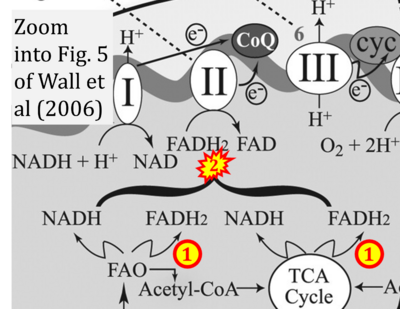Difference between revisions of "Wall 2006 Am J Physiol Heart Circ Physiol"
(Created page with "{{Publication |title=Wall JA, Wei J, Ly M, Belmont P, Martindale JJ, Tran D, Sun J, Chen WJ, Yu W, Oeller P, Briggs S, Gustafsson AB, Sayen MR, Gottlieb RA, Glembotski CC (200...") |
|||
| Line 8: | Line 8: | ||
|editor=Gnaiger E | |editor=Gnaiger E | ||
}} | }} | ||
[[File:Wall 2006 Am J Physiol Heart Circ Physiol CORRECTION.png|right|400px]] | |||
{{Template:Correction FADH2 and S-pathway}} | |||
{{Labeling | {{Labeling | ||
|pathways=F, S | |pathways=F, S | ||
}} | }} | ||
Latest revision as of 10:40, 19 December 2023
| Wall JA, Wei J, Ly M, Belmont P, Martindale JJ, Tran D, Sun J, Chen WJ, Yu W, Oeller P, Briggs S, Gustafsson AB, Sayen MR, Gottlieb RA, Glembotski CC (2006) Alterations in oxidative phosphorylation complex proteins in the hearts of transgenic mice that overexpress the p38 MAP kinase activator, MAP kinase kinase 6. Am J Physiol Heart Circ Physiol 291:H2462-72. https://doi.org/10.1152/ajpheart.01311.2005 |
Wall JA, Wei J, Ly M, Belmont P, Martindale JJ, Tran D, Sun J, Chen WJ, Yu W, Oeller P, Briggs S, Gustafsson AB, Sayen MR, Gottlieb RA, Glembotski CC (2006) Am J Physiol Heart Circ Physiol
Abstract: Ischemia-reperfusion (I/R) has critical consequences in the heart. Recent studies on the functions of I/R-activated kinases, such as p38 mitogen-activated protein kinase (MAPK), showed that I/R injury is reduced in the hearts of transgenic mice that overexpress the p38 MAPK activator MAPK kinase 6 (MKK6). This protection may be fostered by changes in the levels of many proteins not currently known to be regulated by p38. To examine this possibility, we employed the multidimensional protein identification technology MudPIT to characterize changes in levels of proteins in MKK6 transgenic mouse hearts, focusing on proteins in mitochondria, which play key roles in mediating I/R injury in the heart. Of the 386 mitochondrial proteins identified, the levels of 58 were decreased, while only 2 were increased in the MKK6 transgenic mouse hearts. Among those that were decreased were 21 mitochondrial oxidative phosphorylation complex proteins, which was unexpected because p38 is not known to mediate such decreases. Immunoblotting verified that proteins in each of the five oxidative phosphorylation complexes were reduced in MKK6 mouse hearts. On assessing functional consequences of these reductions, we found that MKK6 mouse heart mitochondria exhibited 50% lower oxidative respiration and I/R-mediated reactive oxygen species (ROS) generation, both of which are predicted consequences of decreased oxidative phosphorylation complex proteins. Thus the cardioprotection observed in MKK6 transgenic mouse hearts may be partly due to decreased electron transport, which is potentially beneficial, because damaging ROS are known to be generated by mitochondrial complexes I and III during reoxygenation.
• Bioblast editor: Gnaiger E
Correction: FADH2 and Complex II
- FADH2 is shown as the substrate feeding electrons into Complex II (CII). This is wrong and requires correction - for details see Gnaiger (2024).
- Gnaiger E (2024) Complex II ambiguities ― FADH2 in the electron transfer system. J Biol Chem 300:105470. https://doi.org/10.1016/j.jbc.2023.105470 - »Bioblast link«
Labels:
Pathway: F, S


